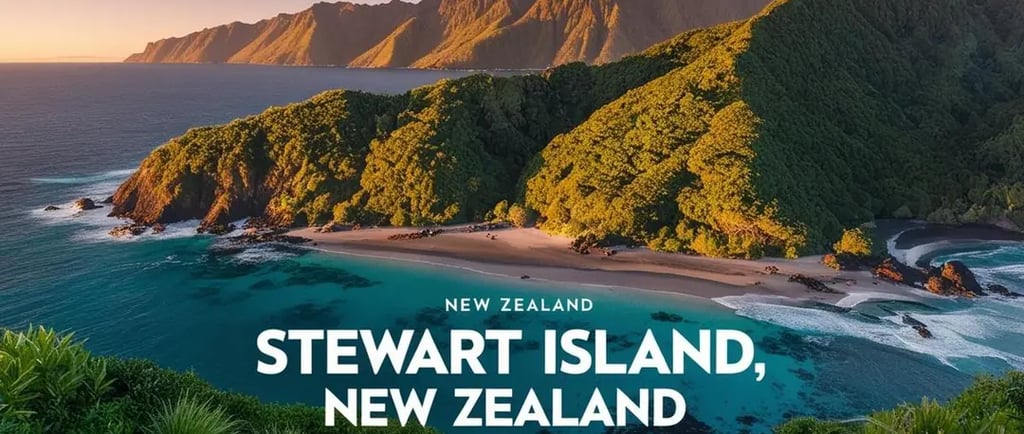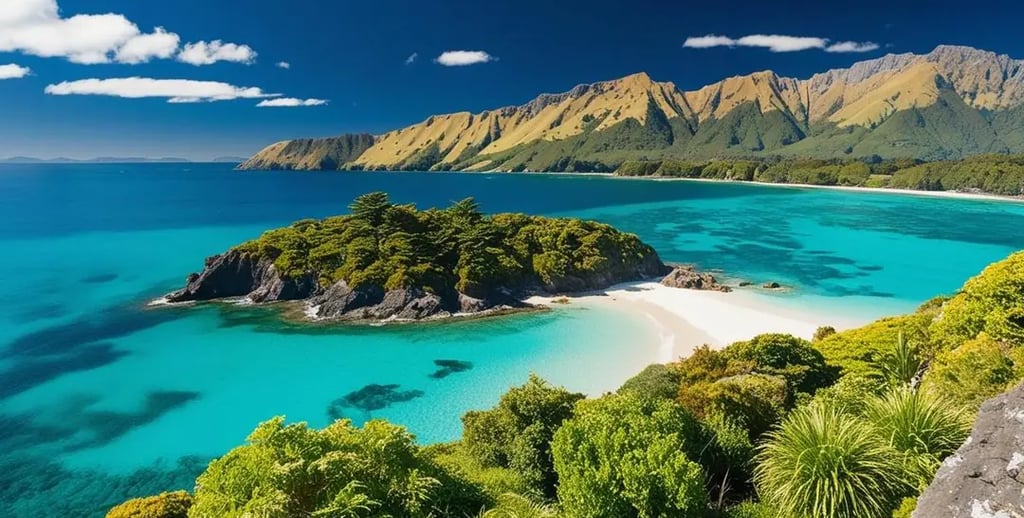Where Nature Rules
Imagine a place where the air is fresh the forests are alive with birds and the ocean sparkles under a starry sky. This is Stewart Island New Zealand’s hidden treasure at the bottom of the world. Known as Rakiura, meaning “glowing skies” it’s a wild and peaceful island where nature is in charge.
🧳 TRAVEL


A Secret Island Far Away
Stewart Island lies 30 kilometers south of New Zealand’s South Island across the choppy Foveaux Strait. It’s New Zealand’s thirdlargest island covering about 1750 square kilometers but only around 400 people call it home. Most live in the small village of Oban leaving the rest of the island to forests beaches and animals. The Māori name Rakiura comes from the island’s breathtaking sunsets and the Southern Lights a colorful glow in the night sky.
Unlike busy places like Auckland or Christchurch Stewart Island feels like a world apart. About 85% of it is part of Rakiura National Park a protected area for nature. Whether you’re walking through green forests kayaking along rocky shores or watching penguins hop onto the beach the island invites you to slow down and enjoy its beauty. Let’s explore what makes this place so special.
Landscapes That Take Your Breath Away
Stewart Island’s scenery is like a painting come to life. Thick forests of tall rimu trees feathery ferns and mossy paths cover the hills. These open to sandy beaches rugged cliffs or quiet bays where the sea meets the sky. The island is wild and untamed with muddy trails and steep climbs that make every step feel like an adventure.
Rakiura National Park
At the heart of the island is Rakiura National Park set up in 2002 to keep its nature safe. Spanning 157000 hectares the park has dense forests marshy wetlands and rocky coasts. Its trails like the Rakiura Track take you through shady trees past bubbling streams and up to lookouts with views of the endless ocean. The Rakiura Track is a 32kilometer loop one of New Zealand’s Great Walks and takes about three days to complete. It’s quieter than other famous trails so you often feel alone with nature.
Beautiful Beaches and Bays
The island’s coastline is just as stunning. Paterson Inlet a calm bay stretches 15 kilometers inland perfect for kayaking or boat rides. Beaches like Horseshoe Bay have soft sand and gentle waves while Mason Bay feels wilder with windswept dunes and driftwood. At low tide you can poke around rock pools filled with tiny crabs starfish and colorful seaweed. Cliffs at places like Deep Bay or Maori Beach add a dramatic touch especially when waves crash during a storm.
Why It Feels Untouched
Stewart Island feels special because it’s so untouched. There are no big highways or crowded towns—just dirt paths small boats and a few gravel roads. You can walk for hours and hear only the wind or a bird’s song. It’s a place where nature sets the rules and humans are just guests.
Wildlife That Makes You Smile
Stewart Island is a playground for animals. Its distance from the mainland has kept it safe for creatures you won’t see anywhere else. From chirping birds to splashing dolphins the island’s wildlife is a big reason people visit.
Birds Everywhere
The island is a birdwatcher’s dream. The kākā a noisy parrot with bright feathers flits through the forest sometimes landing near hikers to check them out. The tui with its glossy black coat and sweet song fills the air with music. At night the ruru a small owl hoots softly adding a spooky charm.
The star of the show is the kiwi especially the tokoeka a type found only here. Unlike other kiwis tokoeka are sometimes active during the day making them easier to spot. With about 20000 on the island you might see one on a guided night tour near Oban or in remote spots like Mason Bay. These fluffy beakprobing birds are a joy to watch.
Ocean Creatures
The seas around Stewart Island are full of life. Paterson Inlet and the Foveaux Strait are home to dolphins seals and sometimes whales. Dusky dolphins love to leap near boats showing off their flips. Fur seals nap on rocks around Port Pegasus or splash in the waves. In winter Southern Right Whales might cruise by their massive tails breaking the surface.
Penguins are another treat. Little blue penguins the smallest kind waddle ashore at dusk in places like Ackers Point. Yelloweyed penguins super rare appear on beaches like West End hopping from the water to their nests. Seeing them shuffle along is like watching a tiny parade.
Ulva Island: A Safe Haven
Just a short boat ride from Oban Ulva Island is a special place where animals rule. It’s predatorfree meaning no rats or possums to harm birds. You can walk its paths and see weka (small hens) robins or bellbirds in minutes. The island’s clear waters are great for snorkeling with fish darting through kelp forests. Ulva feels like a mini version of Stewart Island’s magic.
Why Wildlife Thrives
The island’s animals do well because it’s so remote and protected. Efforts to trap pests and keep places like Ulva safe help birds and marine life flourish. For visitors it’s a chance to see creatures living free not in cages. For locals it’s a responsibility to keep the island clean and safe for these animals.
A Peek at the Past
Stewart Island’s history is as colorful as its landscapes. People have lived here for hundreds of years leaving stories in the land and culture.
Māori Roots
The Māori arrived around the 1200s naming the island Rakiura and weaving it into their myths. They saw it as part of a great canoe tied to the god Māui. Māori families lived by fishing hunting birds and gathering plants respecting the land. Their legacy lives in names like Rakiura and in the island’s deep connection to nature.
European Settlers
In the 1800s European sealers and whalers came followed by settlers in the 1860s. They built lives around fishing and cutting timber settling in what’s now Oban (once Halfmoon Bay). Life was hard with rough seas and long winters but communities grew mixing Māori European and other cultures. You can still see bits of this time like the 1835 stone house at Ackers Point or old sawmill ruins.
Today’s Island
Now Stewart Island blends its past with a quiet present. Fishing for cod and crayfish is still big alongside tourism. The Rakiura Museum in Oban shows off Māori tools whaling gear and photos from the settler days. Locals love their history and many are descended from those early families.
Why History Matters
The island’s past gives it character. Māori stories settler struggles and cultural blends make it more than just a pretty place. When you visit a beach or museum you’re walking through history connected to the people who shaped Rakiura.


Life on the Island
Living on Stewart Island is simple and unique. With only 400 people mostly in Oban it’s a close community where everyone knows your name. Oban has a small shop a pub a school and a few eateries but no big stores or hospitals. Boats and planes bring supplies from the mainland.
A Slow Natural Life
Life here follows nature’s rhythm. Many locals fish guide tourists or run guesthouses. The weather decides a lot—storms can stop ferries while sunny days pull everyone outside. There’s no hurry no crowds just a relaxed vibe where a chat with a neighbor is the day’s highlight.
Joys and Challenges
Island life isn’t always easy. Goods cost more and internet or phone signals can be weak. Winters are chilly and rainy testing your patience. But the payoffs are huge: clean air gorgeous views and a sense of peace. Locals learn to fix things themselves and value small moments like a warm meal or a clear night.
Welcoming Visitors
Tourists are part of life but the island’s size means you need to tread lightly. No camping outside marked spots and you must take your rubbish away. Locals are warm often sharing tips about secret trails or wildlife spots. They just ask that you respect their home and keep it pristine.
Fun Things to Do
Stewart Island is full of ways to enjoy its beauty. Whether you love adventure or want to chill there’s something for you.
Hiking Trails
Walking is the best way to see the island. The Rakiura Track is a threeday adventure through forests and along coasts with huts to sleep in. For shorter walks try the 2hour trek to Maori Beach or the quick climb to Observation Rock for big views. Mason Bay’s long hike rewards you with wide beaches and kiwi sightings.
Water Activities
The ocean is perfect for fun. Kayak in Paterson Inlet to glide past seals or take a boat tour to spot dolphins. Fishing trips let you catch cod or salmon while divers can explore kelp forests and fish. For thrillseekers cagediving with great white sharks is an option (don’t worry it’s safe).
Wildlife Watching
Guided tours make wildlife easy to find. Night walks near Oban or Mason Bay help you spot kiwis or penguins. Ulva Island tours are great for seeing rare birds like saddlebacks. Boat trips to remote bays might bring you close to whales or seal colonies.
Stargazing
Rakiura’s dark skies are a treat. The stars shine bright and the Southern Lights can light up the night with green or pink streaks. Find a quiet spot like Ringaringa Beach or join a stargazing tour to learn about the constellations.
Why It’s Special
These activities let you feel the island’s heartbeat. Hiking its trails or paddling its waters makes you part of the landscape. Watching a kiwi or a starry sky reminds you how amazing nature is. Stewart Island rewards those who take their time.
Why Stewart Island Stands Out
Stewart Island shows what the world can be when nature leads. Its forests animals and seas are a window into New Zealand’s wild past. Efforts to protect places like Ulva Island or keep pests away prove humans can live with nature not harm it.
For visitors it’s a break from the world’s noise. No buzzing phones or crowded streets—just waves birds and open space. It makes you feel small but connected to something huge. For locals it’s a home to cherish a balance of old ways and care for the earth.
How to Visit
Getting to Stewart Island takes a bit of planning. Ferries from Bluff take an hour but can be rough so pack motion sickness tablets. Flights from Invercargill are faster (20 minutes) but cost more. On the island you’ll walk take boats or use small vans to get around.
Stay in Oban’s guesthouses hostels or camping sites but book early for summer (December–February). Winter (June–August) is calmer but wetter. Bring waterproof clothes good shoes and warm layers as the weather flips fast. Follow rules: stick to paths don’t touch wildlife and carry out trash. Check the Department of Conservation website for trail or hut info.